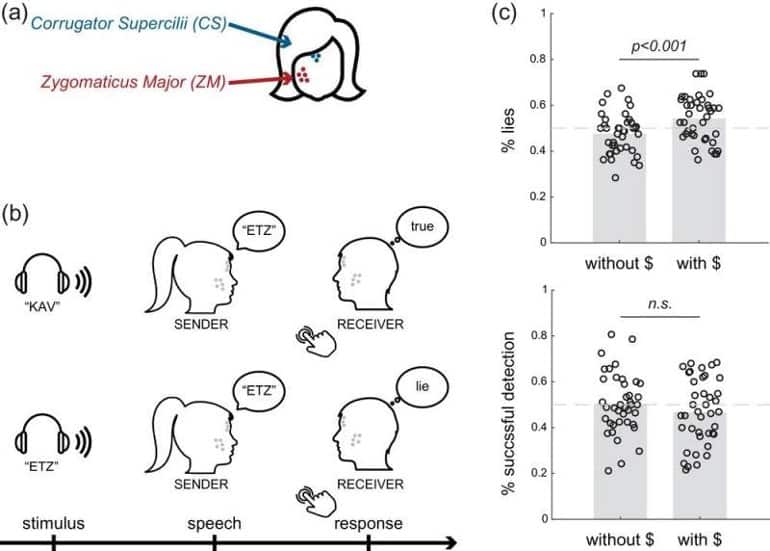Summary: A new technology that measures the movement of facial muscles is 73% accurate at detecting when a person is telling a lie.
Source: Tel Aviv University
Researchers at Tel Aviv University detected 73% of the lies told by trial participants based on the contraction of their facial muscles – achieving a higher rate of detection than any known method.
The study identified two different groups of ‘liars’: those who activate their cheek muscles when they lie, and those who activate their eyebrows.
According to the researchers, the technology has great potential for detecting deception in real-life contexts, such as security and crime.
The study was conducted by a team of experts from Tel Aviv University headed by Prof. Yael Hanein of the Center of Nanoscience and Nanotechnology and School of Electrical Engineering, Iby and Aladar Fleischman Faculty of Engineering, and Prof. Dino Levy from the Coller School of Management. The team included Dr. Anastasia Shuster, Dr. Lilach Inzelberg, Dr. Uri Ossmy and PhD candidate Liz Izakon.
The paper was published in the leading Journal Brain and Behavior.
The new study was founded upon a groundbreaking innovation from Prof. Hanein’s laboratory: stickers printed on soft surfaces containing electrodes that monitor and measure the activity of muscles and nerves.
The technology, already commercialized by X-trodes Ltd., has many applications, such as monitoring sleep at home and early diagnosis of neurological diseases. This time the researchers chose to explore its effectiveness in a different arena – lie detection.
Prof. Levy explains: “Many studies have shown that it’s almost impossible for us to tell when someone is lying to us. Even experts, such as police interrogators, do only a little better than the rest of us. Existing lie detectors are so unreliable that their results are not admissible as evidence in courts of law – because just about anyone can learn how to control their pulse and deceive the machine. Consequently, there is a great need for a more accurate deception-identifying technology. Our study is based on the assumption that facial muscles contort when we lie, and that so far no electrodes have been sensitive enough to measure these contortions.”
The researchers attached the novel stickers with their special electrodes to two groups of facial muscles: the cheek muscles close to the lips, and the muscles over the eyebrows. Participants were asked to sit in pairs facing one another, with one wearing headphones through which the words ‘line’ or ‘tree’ were transmitted. When the wearer heard ‘line’ but said ‘tree’ or vice versa he was obviously lying, and his partner’s task was to try and detect the lie. Then the two subjects switched roles.
As expected, participants were unable to detect their partners’ lies with any statistical significance. However, the electrical signals delivered by the electrodes attached to their face identified the lies at an unprecedented success rate of 73%.

Prof. Levy: “Since this was an initial study, the lie itself was very simple. Usually when we lie in real life, we tell a longer tale which includes both deceptive and truthful components. In our study we had the advantage of knowing what the participants heard through the headsets, and therefore also knowing when they were lying.
“Thus, using advanced machine learning techniques, we trained our program to identify lies based on EMG (electromyography) signals coming from the electrodes. Applying this method, we achieved an accuracy of 73% – not perfect, but much better than any existing technology. Another interesting discovery was that people lie through different facial muscles: some lie with their cheek muscles and others with their eyebrows.”
The researchers believe that their results can have dramatic implications in many spheres of our lives. In the future, the electrodes may become redundant, with video software trained to identify lies based on the actual movements of facial muscles. Prof. Levy predicts:
“In the bank, in police interrogations, at the airport, or in online job interviews, high-resolution cameras trained to identify movements of facial muscles will be able to tell truthful statements from lies. Right now, our team’s task is to complete the experimental stage, train our algorithms and do away with the electrodes. Once the technology has been perfected, we expect it to have numerous, highly diverse applications.”
About this neurotech research news
Author: Press Office
Source: Tel Aviv University
Contact: Press Office – Tel Aviv University
Image: The image is credited to the researchers
Original Research: Open access.
“Lie to my face: An electromyography approach to the study of deceptive behavior” by Anastasia Shuster et al. Brain and Behavior
Abstract
Lie to my face: An electromyography approach to the study of deceptive behavior
Background
Deception is present in all walks of life, from social interactions to matters of homeland security. Nevertheless, reliable indicators of deceptive behavior in real-life scenarios remain elusive.
Methods
By integrating electrophysiological and communicative approaches, we demonstrate a new and objective detection approach to identify participant-specific indicators of deceptive behavior in an interactive scenario of a two-person deception task. We recorded participants’ facial muscle activity using novel dry screen-printed electrode arrays and applied machine-learning algorithms to identify lies based on brief facial responses.
Results
With an average accuracy of 73%, we identified two groups of participants: Those who revealed their lies by activating their cheek muscles and those who activated their eyebrows. We found that the participants lied more often with time, with some switching their telltale muscle groups. Moreover, while the automated classifier, reported here, outperformed untrained human detectors, their performance was correlated, suggesting reliance on shared features.
Conclusions
Our findings demonstrate the feasibility of using wearable electrode arrays in detecting human lies in a social setting and set the stage for future research on individual differences in deception expression.






